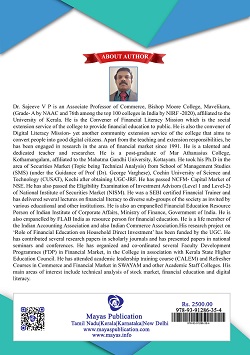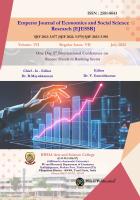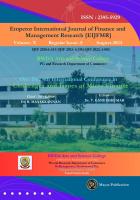- Home
- Books
-
Conference
- "INTERNATIONAL PERSPECTIVES ON RESEARCH METHODOLOGY: CHALLENGES AND OPPORTUNITIES"
- Artificial Intelligence in Finance and Economics
- Behavioral finance
- Day 5th International conference Recent Trends in Banking Sector
- International Conference on Innovations and Transformations Impacting Economy and Business in the Digital Era
- International Conference on Multidisciplinary Research Towards Sustainable Developmen
- International Conference on Social Science, Management and Technology Modern Era
- Two Day International Conference on Financial Innovation and Economic Development
- Emperor Award Name
- International Conference on Multidisciplinary Research
- Journals
- Research Projects
- Services
- Submit Article
- Video Gallery
Predictability of Share Prices In India: A Study of the Applicability of Technical Analysis
About the book
Description

I am very much pleased to present this book which is the result of several years of research. Everyone is interested in the forecast and happier if it actually matches it, especially if the forecast relates to positive aspects of life. Financial forecasts about the return particularly the asset price so as to improve one’s wealth cannot be an exception. Different approaches are followed to identify mispriced assets in the market so that the portfolio is modified by replacing overpriced assets with those under-priced. Most often, the continuation of a mispriced situation necessitated a further trigger to implement entry and exit decisions in the market that
complement fundamental analysis. Besides this, emotions and sentiments may dominate decisions, especially when they relate to money matters. This is where technical analysis has traditionally been trusted and acted upon. However, there is no reporting of the actual success rate of the prediction tool as to its reasonable gain when used repeatedly so that the same tool can be again used later or by others. It means it has not grown into a mature science so as to get the same result on replication. This book is a work in this line as it is about the applicability of technical analysis. The more the price fluctuations, the more are opportunities to make a profit. Then the natural choice is financial assets in the stock market. Security prices are the best-chosen category of assets for their fluctuations.
Technical analysis is made of the prices of securities in the Indian Stock market to know their success rate. There are certain patterns and indicators that are preferred traditionally by most and widely reported. Their validity is examined in this book. Different decision-optimities that are usually available within the regulatory system and also pragmatic are considered trading strategies to test.
Technical analysis being a segment of security analysis that is used to generate ‘buy signals’ and ‘sell signals’ has been a century-old stock market practice, though academic interest and literature on it as a science of market analysis has not grown that much. Controversy about its predictability can be a major reason. However, this tool is practiced widely nowadays. The number of persons using it, demanding and issuing signal tips from it has been increasing day by day. Quarries in diverse online stock market groups evince it. For decades, there has been a prescription of this topic in the syllabi of various educational programs, at least as a module or chapter. The consistency of success of certain aspects of the literature is illustrated here. Let the reader test the tools in their real-life trade and arrive at the success rate of each technical tool out of their long-term experience rather than embracing and sticking to judgment on a few casual wins or losses. The longitudinal approach used in this book for the calculation of return resembles the usual real trades in the market that may start and end at any time, considering many do it.
Technical analysis being a segment of security analysis that is used to generate ‘buy signals’ and ‘sell signals’ has been a century-old stock market practice, though academic interest and literature on it as a science of market analysis has not grown that much. Controversy about its predictability can be a major reason. However, this tool is practiced widely nowadays. The number of persons using it, demanding and issuing signal tips from it has been increasing day by day. Quarries in diverse online stock market groups evince it. For decades, there has been a prescription of this topic in the syllabi of various educational programs, at least as a module or chapter. The consistency of success of certain aspects of the literature is illustrated here. Let the reader test the tools in their real-life trade and arrive at the success rate of each technical tool out of their long-term experience rather than embracing and sticking to judgment on a few casual wins or losses. The longitudinal approach used in this book for the calculation of return resembles the usual real trades in the market that may start and end at any time, considering many do it.
ACKNOWLEDGEMENTS
With boundless gratitude and great respect, I express my heartfelt obligation to my Supervising Guide Dr. K. GEORGE VARGHESE, Professor and ex-director, of the School of Management Studies, Cochin University of Science and Technology for his expert guidance, whole-hearted support, and constant encouragement without which this work would not have been completed. I consider it a privilege to have been able to work under his supervision and guidance. I am very much indebted to the help and counsel received from Prof. N. RANGANATHAN, Prof. P. R. PODUVAL, and Prof (Dr.) JOSE T. PAYYAPALLY, Prof. (Dr.) K. K. GEORGE Prof. (Dr) P.R. WILSON, and Prof. (Dr.) K. SUDHARSANAN PILLAI in their capacity as Directors of the School of Management Studies, Cochin University of Science and Technology. Cochin-22. I have been very much helped by them during their respective tenures. I am also grateful to Prof. M. K. Sukumaran Nair, Department of Applied Economics, Cochin University of Science and Technology for his constructive suggestions on my work. The computer facility for the analysis of the data was provided by Elvee Associates, Security Broker, Kochi-35. I am greatly indebted to its proprietress Mrs. Lissie Varghese, (former Member of the erstwhile Cochin Stock Exchange) for the esteemed and boundless sacrifice extended to me. My deep sense of gratitude is also due to all the staff in the Office and the Libraries of the School of Management Studies and the Department of Applied Economics, Cochin University of Science and Technology, Kochi -22. It is with the great obligation that I acknowledge the sincere help granted to me by the Librarians of the:
Institute of Financial Management and Research (IFMR), Chennai.
Indian Institute of Public Administration, New Delhi.
Institute of Chartered Accountants of India, New Delhi.
Rattan Tata Library, Delhi School of Economics, New Delhi.
National Institute of Public Finance and Policy, New Delhi.
Federation Of Indian Chambers of Commerce and Industry, (FICCI), New Delhi.
Society for Capital Market Research and Development, New Delhi.
Institute of Chartered Financial Analysts of India (ICFAI), Hyderabad.
Indian Institute of Management, Ahmedabad.
Tata Institute of Social Science, Mumbai.
Indira Gandhi Institute of Development Research, Mumbai.
Bombay Stock Exchange Library, Mumbai.
UTI Institute of Capital Market Research, Mumbai.
I acknowledge the cooperation of all my friends and well-wishers. I remember my parents for their boundless sacrifice, help, and encouragement without which I would not have come up to this. There are many others from whom I have drawn much, directly and indirectly, during the course of my research.
Dr. SAJEEVE .V .P
Details
ISBN
978-93-91286-32-3
Imprint
Mayas Publication
Published
2022
Copyright
Copyright © 2025 Mayas Publication
Publishing Limited. All rights reserved.
You currently don’t have access to this book, however you can purchase separate chapters directly from the table of contents or buy the full version.
Purchase the book




